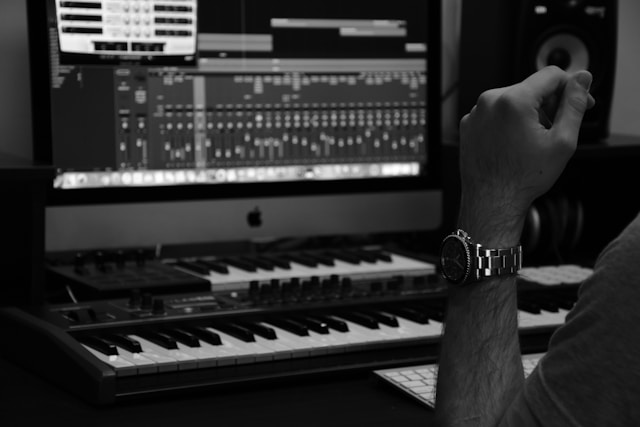From exploring sound design in podcasts to analyzing the interplay between product and sound in broadcast commercials, Altered State Productions’ media director shares his insights on how sound influences audiences.
Close your eyes for a moment. Imagine you’re in a dimly lit dive bar. Hear the soft buzz of conversations drifting around you like a comforting blanket. Suddenly, the sharp pop of a beer can opening cuts through, crisp and clear. There’s the ping of a text notification nearby—someone anxiously waiting, maybe for a friend, or could it be a date?
Each beep adds a layer of intrigue to the atmosphere. Listen to the scrape of stools against the concrete floor blending with the soft thud of a whiskey bottle placed on the bar, followed by the soothing sound of liquid pouring into a glass. Let yourself sink into the scene. Notice how these sounds draw you in, creating an atmosphere that’s unmistakably real. This is where our journey into Eddie Castillo’s world of video editing begins.
On average, a person may hear anywhere from 20,000 to 50,000 individual sounds in a single day. How many of those do you think come from video advertising? It’s a curious thought, isn’t it? You may not remember most of these sounds because they often leave a subconscious imprint, subtly influencing your decisions without you even realizing it. How does that make you feel, knowing that your choices might be shaped by what you hear, not just what you see?
Eddie Castillo has generated over a quarter billion dollars for brands and businesses worldwide through his video content. Known for his expert video editing, Eddie has produced dynamic advertisements for notable clients like The Ocean Foundation and UPS. His proficiency extends into podcast production and music syndication, adding depth to the media he creates. Castillo’s impactful projects, which have significantly boosted engagement metrics, are featured on major platforms such as iTunes, iHeartRadio, and Amazon, shaping how audiences think and feel.
Castillo discusses his experiences working on ads across various industries, where he was sometimes instructed to use specific triggering sounds, while at other times, he was directed to avoid them entirely. This strategic use of sound is rooted in its proven ability to influence behavior. “If the devil is in the details,” suggests Eddie Castillo, “then where does the soul reside? Clearly, it lives in the sound.”
Sound design is composed of four types: ambiance, SFX, dialogue, and music. Each type is strategically layered to extract and enhance the soul of the message.
First Layer: Ambiance
Ambiance serves as an immediate cue through sound, setting the stage and introducing viewers to the environment before they see anything. Whether it’s the constant hum of a laundromat, the vibrant cheers at a local baseball game, or the faint, eerie creaks in an old house, each ambient sound establishes the scene and evokes a visceral response. These sounds unlock memories and familiarize you with the setting.
How do you feel? Does the laundromat make you feel impatient, your leg shaking as if you are there? Or do the cheers from the baseball game stir feelings of nostalgia—or perhaps anxiety as you anticipate what might happen next?
Second Layer: Sound Effects (SFX)
Following ambiance, SFX deepens the sensory journey, moving you from recollection to vivid presence. This is the phantom effect of sound effects at play. You hear the definitive click of a car lock, and suddenly, you’ve arrived. The pop and crackle of bubble wrap evoke a rush of excitement. The abrasive sound of scratching makes your own skin itch in sympathy. Coins clinking on the floor of a karaoke car in Vegas bring a sense of irony and carelessness. Sound effects give texture and weight to every scene, meticulously creating a tangible reality that pulls you into the heart of the moment, making every detail palpably felt as if you are living within the scene itself.
Third Layer: Music Score
Following sound effects, the music score sets the pace and defines the atmosphere of the most popular ads. Electro synths pulse through the scene, charging it with vibrant energy that pushes your excitement levels to the max. Piano keys cascade, touching the heart with their soft melodies. And violins, well, violins just make everything fancy. They effectively compress the essential elements—like building tension and dramatic peaks—into a condensed format. This strategy ensures that every beat of music punctuates the narrative arc, capturing attention and enhancing the message swiftly. A great music score colors every moment, deepening the ad’s impact by syncing sound with visual intent.
Does the beat drop of electro elevate your mood and make you subconsciously excited the next time you see that brand online? Or does the melody of the piano make you reach for your wallet and donate? Music coaxes emotions that drive action. This isn’t just a song that cuts to the beat; it’s how those sounds make you act.
Fourth Layer: Dialogue
Drowned out conversations and a couple laughing in the background reclaim the ambiance. The sound of a woosh zooms into ice hitting the glass and makes a distinct splash, followed by the click of high heels and the brief blare of mic feedback. Then, the music takes over: “Havana, ooh na-na (AYY, AYY).” Dialogue is now ready to enter. It polishes off the experience, delivering the final thrust. Clear, impactful, and expertly timed, it threads through sound, guiding focus and momentum to the unfolding message. If all the other sound components were the stage and actors, the dialogue is the spotlight that directs your ears, making you tune in and follow along just as closely as your eyes would. With countless spotlight options available, choosing the right one is where editors truly have the ultimate say in the final message delivered.
It’s here, where dialogue steers the narrative home.
“He took me back to East Atlanta, na-na-na,” you hear a warm, inviting voice cut through the lively backdrop: “Caught in the moment? Keep the vibe alive.
Visit [Brand Name] online.”
It’s more than a suggestion; it’s a call to action—clear, compelling, urgent. Another voice chimes in, equally charismatic: “Or call us now, and let’s make your night unforgettable with [Brand Name].”
See how quickly the intention of this ad changed with just simple dialogue? Words are verbal handshakes, extending an invitation directly to you. This type of sound does more than communicate; it connects, it convinces—it directs your next move.
Sound design, with its complex decisions, long hours, and meticulous attention to detail, is Castillo’s passion, drawing together an incredible community of creatives he deeply values. Each element, from ambiance to dialogue, actively shapes and defines the scene—it grabs you by the senses and doesn’t let go. Ultimately, it’s the push you didn’t know you needed, driving you, and if done right, sometimes literally straight to the store.
Altered State Productions has been rated as one of the top sound production companies and houses award-winning audio engineers and video editors. To learn more, visit Alteredstateprod.com.


